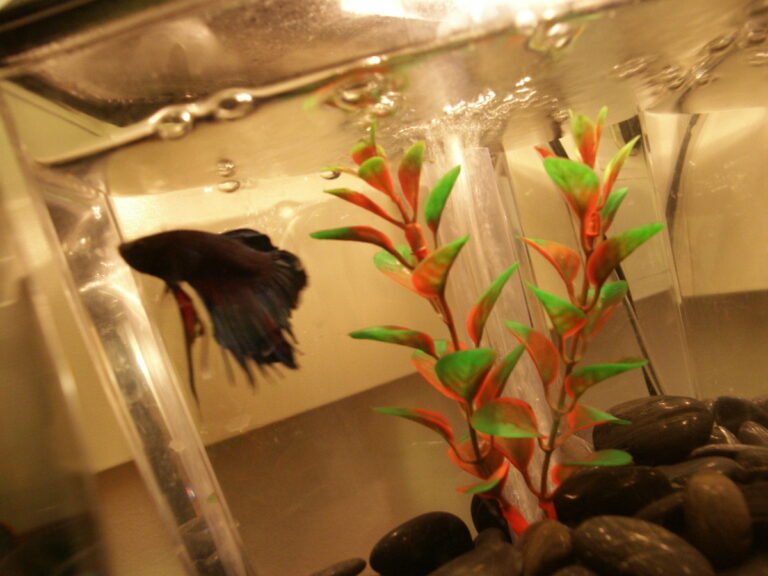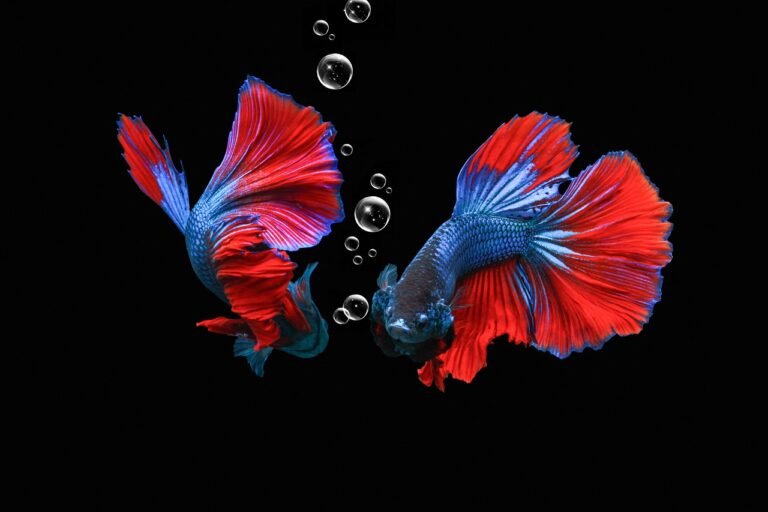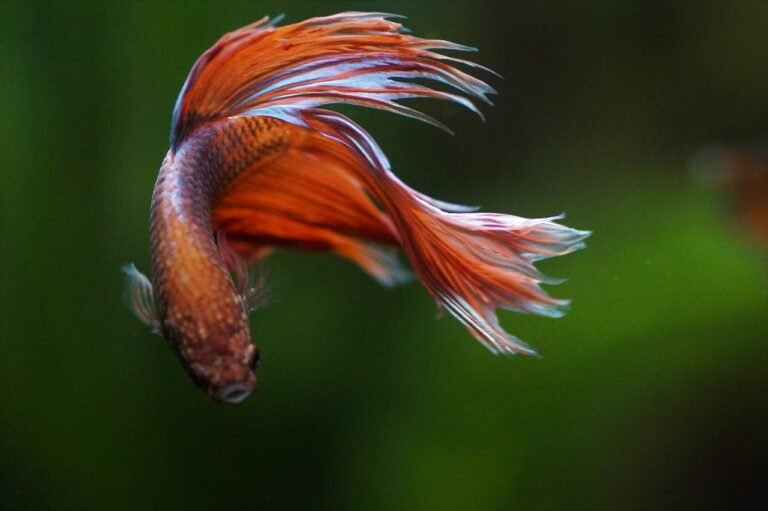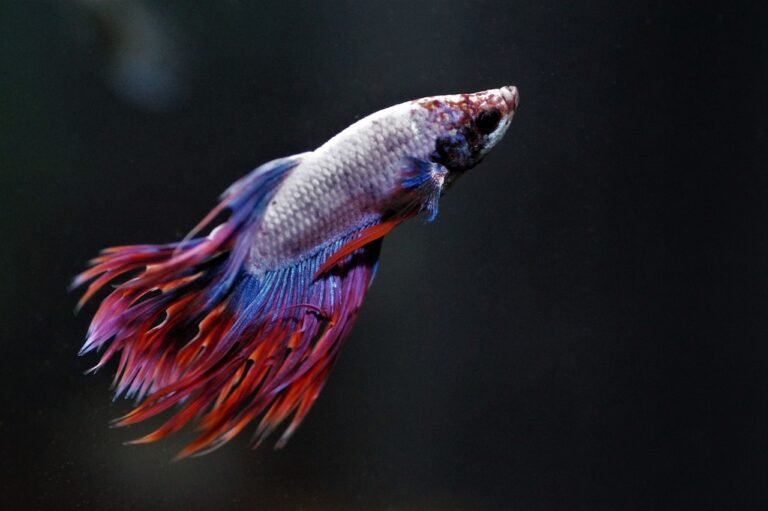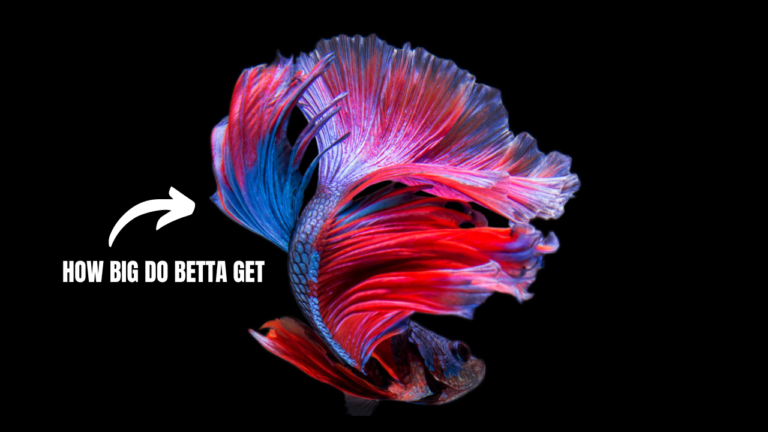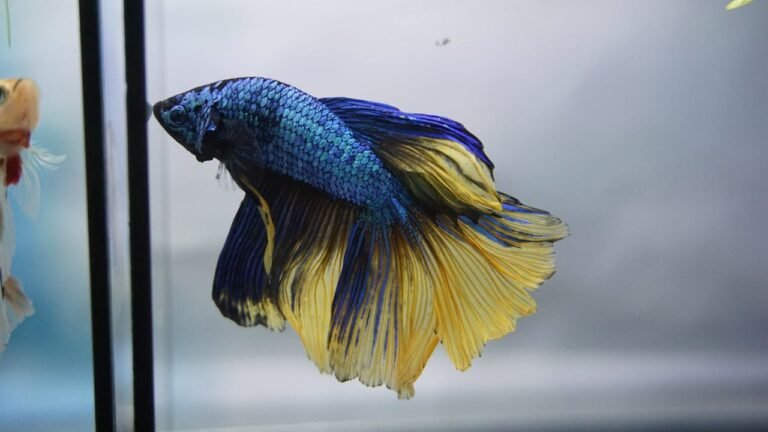Betta fish, also known as Siamese fighting fish, are fascinating creatures where bright colors meet interesting patterns. Aquarists around the globe have fallen in love with these magnificent creatures, and one of the most captivating aspects is the distinctive contrasts between males and females. This comprehensive guide will discuss female vs. male betta fish, their physical attributes, behavior, and compatibility.
Betta splendens, commonly known as Bettas, are native to Asia’s rice paddies and move slowly. These hardy fish have evolved to survive in harsh environments, which makes them an interesting aquatic pet. Whether you are new to this pastime or already a seasoned aquarium owner, knowing the differences between male and female bettas can help you decide how best to care for your finned friends.
Physical differences between female and male
One of the most stunning discrepancies between female and male betta fishes comes from their appearances. The male bettas are famous for being very colorful, having long fins, and overall bigger sizes. Some of those fins might extend gracefully, producing a mesmerizing flow of shades and patterns. On the other hand, ladies usually appear more minor, with short fins and less vivid coloring.
Here is a closer look at the physical traits of female &male betta fishes:
Male Betta Fish
- Bigger body size that attains 3 inches at times
- Long flowing fins that may measure several inches in length
- Bright colors, including reds, blues, greens, etc., intricate patterns, as well as iridescent hues
- Prominent gill covers and oversized ventral fins
- More aggression, especially toward other males
Female Betta Fish
- Smaller body size, which ranges around 2-2.5 inches in length
- Shorter fins characterized by a rounded appearance, mostly resembling lips
- Subdued coloration, which is often seen in browns, blues, or reds
- Less pronounced gill covers and smaller ventral fins
- Mostly less aggressive behavior compared to males
However, while these are typical physical traits, there may be individual variations, and some females may have more intense or longer fins than others.
Behavioral differences between female and male
Yet, in addition to their physical outlooks, female and male betta fish are characterized by diverse behavioral patterns that must be known to properly care for them. These distinctions in behaviors arise from the innate instincts and evolutionary adaptations of each male or female betta.
Male Betta Fish Behavior
Territoriality and aggression define a male betta fish, particularly when it concerns his premises being invaded by other males. This is why they dare to create outposts full of lush plants where the fry can safely hide from predators.
- Territorial aggressiveness towards fellow males
- Flaring of gill covers and fanning out of fins to demonstrate superior breeding rights
- Creating bubble nests used for luring females during the mating process & protecting youths
- Courtship displays featured fin movement intricacy along with color changes
Female Betta Fish Behavior
In contrast, female Betta fish tend to be less aggressive than males. Their primary focus is on nurturing their young ones while ensuring their continuous existence through reproduction.
Some of the common behavioral characteristics exhibited by female Bettas include:
- Less aggression toward other females, although there may be some squabbling
- Maternal instincts in terms of guarding and taking care of eggs and fry
- Response to courtship display by males during breeding seasons
- A tendency to establish a pecking order in groups, with dominant females who assert their position
Considering these behavioral differences when keeping betta fish is essential, as they can significantly impact their welfare and compatibility with other tank inhabitants.
Choosing between female and male betta fish as pets
When it comes to choosing between female and male betta fish as pets, many factors come into play. There are advantages and challenges associated with both genders, so it will depend on your personal choices, experience levels, and aquarium setup, among other things.
Advantages of Male Betta Fish
- Bright colors and impressive fin displays
- Available at pet shops or online stores conveniently
- Can be kept alone since they are territorial by nature
- Bubble-nesting behavior for those interested in breeding
Advantages of Female Betta Fish
- Generally less aggressive, making them ideal for community tanks
- Can be kept in small groups or sororities (with proper precautions)
- Plain coloration may appeal to those who prefer a more natural-looking fish house.
- Less likelihood for fin nipping, hence reduced risks of aggression towards other tankmates.
Considerations for Both Genders
- Proper tank setup and water conditions are crucial for their health and well-being
- Adequate hiding spots and visual barriers are necessary to reduce stress
- Regular water changes and high-quality food are essential for their care
- Monitoring for signs of aggression or stress is vital, especially in community tanks
Ultimately, the choice between female and male betta fish depends on your preferences, experience level, and the specific setup you plan to create. Both genders can make rewarding and captivating pets when provided with the appropriate care and environment.
Tank setup for female betta fish
Creating an appropriate tank setup is crucial for the well-being and longevity of your female betta fish. While their requirements may vary slightly from those of their male counterparts, providing a suitable environment is essential for their health and happiness.
Tank Size and Water Parameters
Female betta fish can thrive in smaller tanks, but providing at least a 5-gallon aquarium for a single female or a 10-gallon tank for a sorority (group of females) is recommended. This allows ample swimming space and helps maintain stable water parameters.
Ideal water parameters for female betta fish include:
- Temperature: 78°F to 82°F (25°C to 28°C)
- pH: 6.5 to 7.5
- Ammonia and Nitrite: 0 ppm
- Nitrate: Below 20 ppm
Regular water testing and partial water changes (25-30% weekly) are crucial to maintain these parameters and ensure a healthy environment.
Decorations and Plants
Male betta fish appreciate a well-planted aquarium with plenty of hiding spots and visual barriers. Live plants such as java ferns, Anubis, and cryptocoryne offer a natural environment that helps reduce stress. Besides, driftwood rocks and ceramic decorations can create caves for territories within which males establish their dominion.
Substrate and Lighting
Sand or small gravel works best when housing male care for Bettas because they prevent damage to their delicate fins. Moreover, proper lighting must also be ensured where moderate-low light setups are preferred to resemble their natural habitat.
Filtration and Aeration
A mild filtration system is crucial in maintaining high-quality water; however, it is essential to avoid having a powerful flow, as males prefer calmer waters. Also, an air stone or surface agitation can help oxygenate the water and provide gentle movement on the topmost part.
Tank setup for male betta fish
While male betta fish have basic requirements similar to those of their female counterparts, their territorial nature and unique behaviors necessitate specific considerations when setting up their tank environment.
Tank Size and Water Parameters
Male betta fish are typically housed in individual tanks due to their aggression towards other males. A minimum tank size of 5 gallons is recommended, but larger tanks (10 gallons or more) provide more swimming space and better water quality stability.
The ideal water parameters for male betta fish are similar to those for females:
- Temperature: 78°F to 82°F (25°C to 28°C)
- pH: 6.5 to 7.5
- Ammonia and Nitrite: 0 ppm
- Nitrate: Below 20 ppm
Regular water testing and partial water changes (25-30% weekly) are crucial to maintain these parameters and ensure a healthy environment.
Decorations and Plants
Male betta fish appreciate a well-planted aquarium with plenty of hiding spots and visual barriers. Live or silk plants, such as java fern, anubias, and cryptocoryne, provide a natural environment and help reduce stress. Additionally, driftwood, rocks, and ceramic decorations can create caves and territories for the male to establish his domain.
Substrate and Lighting
A soft, fine-grained substrate, such as sand or small gravel, is ideal for male betta fish, as it helps prevent damage to their delicate fins. Adequate lighting is also essential, with a moderate to low-light setup preferred to mimic their natural habitat.
Filtration and Aeration
A gentle filtration system is necessary to maintain water quality, but it’s essential to ensure the flow is strong enough, as male betta fish prefer calmer waters. An air stone or surface agitation can also help oxygenate the water and provide gentle surface movement.
Bubble Nest Considerations
Male betta fish are known for their bubble-nesting behavior. They create a bubbly nest at the surface to attract females and protect their offspring. A suitable surface area and gentle water movement can encourage this natural behavior and enhance the male’s overall well-being.
Compatibility with other fish – betta fish vs goldfish
When housing betta fish with other species, it’s crucial to consider their compatibility and potential for aggression. One common question is whether betta fish and goldfish can coexist peacefully in the same aquarium.
Betta Fish vs Goldfish: Compatibility Concerns
Betta fish and goldfish have vastly different environmental requirements, making it challenging to provide a suitable habitat for both species simultaneously. Here are some key considerations:
- Water Temperature: Betta fish thrive in warm water temperatures ranging from 78°F to 82°F (25°C to 28°C), while goldfish prefer calmer waters between 65°F and 72°F (18°C to 22°C).
- Water Flow: Betta fish prefer calm, gentle water flow, while goldfish require more oxygenated water with moderate to strong currents.
- Tank Size: Goldfish are messy fish that produce significant waste, requiring larger tank volumes (at least 20 gallons for a single fancy goldfish) to maintain water quality. Betta fish can thrive in smaller tanks but still require adequate swimming space and stable water parameters.
- Aggression: While betta fish are generally peaceful towards other species, they can become territorial and aggressive towards fish with long, flowing fins, such as fancy goldfish varieties. Conversely, goldfish may inadvertently nip at the betta’s delicate fins due to their constant grazing behavior.
Compatibility with Other Fish Species
While betta fish and goldfish may not be the best tankmates, other fish species can coexist with betta fish in a community aquarium. Some compatible options include:
- Tetras (Neon, Cardinal, Ember)
- Corydoras Catfish
- Otocinclus Catfish
- Guppies
- Platies
- Swordtails
- Danios
Research each species’ specific requirements and behavior before introducing them to a betta fish tank. Providing ample hiding spots, visual barriers, and monitoring for signs of aggression or stress is crucial for a harmonious community.
Breeding female and male betta fish
Breeding female and male betta fish can be a rewarding and fascinating experience for experienced aquarists. However, it requires careful planning, proper setup, and a deep understanding of the breeding process and requirements.
Selecting Breeding Pairs
The first step in breeding betta fish is selecting healthy and vibrant breeding pairs. Look for mature fish with bright colors, well-developed fins, and no signs of disease or deformities. Choosing a pair from different genetic lines is essential to ensure genetic diversity and avoid inbreeding.
Conditioning and Spawning
Before breeding, the female and male betta fish need to be conditioned with a high-protein diet to ensure optimal breeding conditions. This process can take several weeks.
Once the fish are ready, they are introduced to a dedicated breeding tank. The male will construct a bubbly nest at the surface, and courtship displays will commence. If the female is receptive, the male will embrace her, and spawning will occur.
Caring for Eggs and Fry
After spawning, the female should be removed from the breeding tank to prevent her from eating the eggs. The male will tend to the nest, protecting and aerating the eggs until they hatch.
Once the fry (baby fish) hatch, they feed on their egg sacs. After a few days, they will require specialized fry food and frequent water changes to maintain water quality.
Raising Fry to Maturity
As the fry grow, they must be separated into smaller groups to prevent overcrowding and aggression. Regular water changes, high-quality food, and close monitoring are essential during this stage.
At around 3-4 months, the juvenile betta fish will begin to develop their adult coloration and fin patterns. This allows you to identify their gender and potential for breeding or keeping as pets.
Considerations and Challenges
Breeding betta fish can be challenging and time-consuming, requiring patience, dedication, and a thorough understanding of their breeding behavior and requirements. Researching and preparing thoroughly before attempting to breed betta fish is essential, as improper care or conditions can lead to unsuccessful spawns or the loss of fry.
Caring for female and male betta fish
Proper care and maintenance of optimal living conditions are important to ensure the welfare and lives of both female and male betta fish. Although their basic requirements are similar, there are nuances based on gender and individual needs.
Water Quality and Tank Maintenance
For your betta’s health, you should always strive for excellent water quality. Regular partial water changes (25-30% weekly) are vital so that waste buildup can be cleared away and water parameters stabilized. Also, it’s important to test water regularly for safe ammonia, nitrite, and nitrate levels in betta fish tank.
Feeding and Nutrition
Betta fish need a wide range of high-quality protein sources as predatory animals. Their diet should include a mix of live, frozen, high-quality pellet or flake foods. Varying the foods helps ensure they get sufficient nutrients required by different species.
Avoid overfeeding, as small stomachs can quickly cause betta fish to develop obesity or digestion problems. Feed them small amounts two or three times per day, and after some minutes pass, remove any uneaten food items.
Tank Decor and Environment
Hiding spots and visual barriers are much appreciated by both female and male bettas in a well-planted aquarium. Natural materials such as living or silk plants, driftwood, rocks, and ceramic ornaments can create this environment.
Well-being must also be maintained through maintaining the correct environmental conditions, including age, gentle filtration, and surface agitation (water temperature 78°F to 82°F or 25°C to 28°C).
Monitoring for Signs of Stress or Illness
It is crucial for your bettas’ health to constantly monitor them if they show signs of stress or illness. These signs include loss of appetite, lethargy, clamped fins, discoloration, or strange swimming behavior.
Once these appear, you should act fast by changing the water immediately, adjusting tank conditions, or consulting a knowledgeable aquarist or veterinarian.
Handling and Acclimation
To introduce a new betta fish to your aquarium or transport it, you must follow the proper acclimation process. Gradual acclimation should allow the fish to get used to the temperature and chemistry bit by bit, reducing stress and shock.
Given their delicate fins and bodies, bettas should only be handled with care if necessary. Soft fine-mesh nets or cupping them gently are ideal so as not to cause unnecessary stress or injury.
By adhering to good care practices, maintaining an appropriate living environment, and being observant of their condition, you can ensure that your male and female betta fish live well for many years and show off their beautiful coloration when they swim around their tank.
Wrapping Up !
From their distinct physical appearances to their contrasting temperaments, these magnificent creatures offer aquarium enthusiasts a diverse range of options to explore.
Whether you choose the stunning, flowing fins and vivid hues of a male betta or the more subdued elegance of a female, providing them with a suitable environment, proper care, and understanding their specific needs is crucial for their well-being and longevity.
Remember that male and female bettas can make lovely and captivating pets with proper care and attention. With patience, dedication, and a keenness to learn, you can establish a thriving aquatic ecosystem that reflects the beauty and hardiness of these fantastic creatures.


